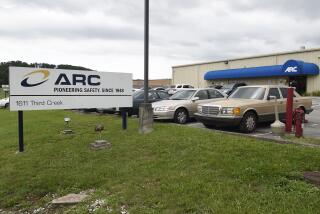Goodyear Tire Fatalities Echo Firestone’s Troubles
A series of tire failures similar to the ones that have plagued Bridgestone/Firestone have afflicted light-truck tires manufactured by Goodyear Tire & Rubber Co., killing at least eight people but so far drawing little attention from federal safety regulators.
The Goodyear tire failures involve 16-inch Load Range E tires manufactured mainly for commercial vehicles--trailers, passenger vans and large sport-utility vehicles.
Goodyear became aware of what one of its own engineers labeled an “alarming” problem with the tires five years ago and made a design change to make the tires stronger. But it did not recall the older tires, millions of which are still on the road, including the popular Goodyear Wrangler AT and HT.
The Akron, Ohio-based tire maker defended its actions, saying it found no defects in the tires, but it has quietly settled several of at least 20 lawsuits resulting from the crashes. Settlement amounts and company documents turned over in these cases have been kept secret, a move that has drawn the ire of consumer groups and plaintiffs attorneys.
The suits blame tread separation, virtually identical to the problems experienced by Firestone, whose tires--fitted on Ford Explorers--have been linked to more than 150 deaths and more than 500 injuries worldwide.
The Goodyear tire failures are the latest example of how deadly crashes caused by tread separations have transcended the Firestone-Ford Explorer case and are bedeviling the whole tire industry. In addition to the Firestone recall, Continental-General announced last month that it will replace 160,000 tires, mostly mounted on 1998 and 1999 Lincoln Navigators, because the tread showed a tendency to separate. Other large tire makers are also grappling with the problem.
Although the deaths and injuries related to Goodyear’s light-truck tires are relatively small, attorneys say no one really knows how many casualties have resulted from failure of Goodyear’s light-truck tires because there has been virtually no publicity about them.
Officials with the National Highway Traffic Safety Administration acknowledged Tuesday that during the last three years they have received 59 reports of tire failures--including one fatality--involving Goodyear light-truck tires. Asked whether the agency plans to open an investigation, NHTSA spokesman Rae Tyson said, “We’re continuing to monitor the situation.”
In March, NHTSA opened a preliminary investigation of several models of Firestone tires after receiving 81 reports. Since Bridgestone/Firestone’s voluntary Aug. 9 recall of 6.5 million tires, NHTSA has been deluged with more than 3,000 additional complaints.
Goodyear officials acknowledged this week that they began noticing a large number of complaints involving the light-truck tires as early as 1995. The company conducted extensive tests and reviewed its design and manufacturing processes to see whether they were at fault.
Goodyear decided not to tell safety regulators about these complaints because the tests indicated the tires were not flawed. “We believe the Load Range E tires to be good tires free of any manufacturing or design defects,” said Goodyear spokesman Chuck Sinclair.
“Tread separations do not necessarily indicate a defect in a tire,” Sinclair said. “A tread separation, which today is the most common form of tire failure, is normally the end result of something else that has happened to a tire.”
Goodyear believes other factors may be responsible. “What we did see during this [review] process was the start of an evolution of a new breed of larger vehicles, pickups, vans and towed vehicles, and trends in modifications to those vehicles that might lead to overloading of the tire,” Sinclair said.
That observation led Goodyear in 1996 to start putting an extra layer, or so-called nylon cap, on Load Range E tires to make them more robust, he said. The more robust construction has resulted in fewer claims against Goodyear, a company engineer has testified.
But millions of the older, unreinforced light-truck tires remain on the road, including the Goodyear Wrangler AT, Goodyear Wrangler HT, Goodyear Allseason Workhorse, Kelly-Springfield Power King and Kelly-Springfield Trailbuster.
And, according to court records, fatal crashes involving these tires began piling up--from Saudi Arabia to Florida to California.
Among the accidents:
* In August 1995, a Ford Club Wagon van returning 13 Whitman College students to Walla Walla, Wash., from an outing to Yellowstone National Park rolled after the tread on a Goodyear tire separated. A 19-year-old student was killed and 12 were injured.
* In January 1996, LAPD bomb-squad officer Brian D. Matthews was driving his Chevrolet Suburban to an emergency call in the San Fernando Valley when the tread separated from a Goodyear tire on the police vehicle. The Suburban flipped several times, ejecting Matthews, who was left a paraplegic.
* In July 1997, three U.S. Air Force personnel were killed and three were injured when a Goodyear tire on their GMC Suburban came apart, causing the vehicle to roll several times on a desert highway near Riyadh, Saudi Arabia. Court documents showed that in 1997 the U.S. Air Force ordered all Load Range E tires to be removed from its fleet of Suburbans in Saudi Arabia after recording five other nonfatal accidents involving tread separations within a month.
* In December 1997, the tread separated on a tire on a 1990 Ford Econoline van transporting six migrant farm workers in Florida, killing two and seriously injuring the others. Goodyear has settled one of the lawsuits filed against the company.
* In May, a Ford school van transporting eight Arizona high school honor students and three school teachers on a trip to New Mexico crashed after the tread separated on one of the tires. The arm of an art teacher was severed and at least three students were injured.
Sinclair, the Goodyear spokesman, said the first serious injury case brought to the company’s attention involved the LAPD bomb squad officer. He said Matthews was driving a modified vehicle at an estimated speed of 85 to 90 mph through a construction zone and was not wearing a seat belt.
An examination indicated impact damage to the tire, probably from striking something, before the separation and accident occurred, Sinclair said.
Matthews’ attorneys dispute Goodyear’s assertions.
Last year, Goodyear, GM, the state of California, and another co-defendant paid $7.9 million to settle the officer’s damage suit. Goodyear’s share of that settlement remains confidential and Matthews’ lawyer, Christine Spagnoli of Los Angeles, was required to return all the documents to Goodyear.
But before doing so, Spagnoli was retained by two families of dead U.S. servicemen and a survivor of the Saudi Arabian accident.
At Goodyear’s request, many of the same documents have been kept under seal. Goodyear says the information is proprietary and contains valuable trade secrets.
Spagnoli said she thinks the company is not giving the public all the facts about the safety of its light-truck tires. “From what we know so far, there appears to be a trend showing that these tires are failing,” said Spagnoli, who recently compiled a list of 14 accidents involving more than 20 injuries resulting from Goodyear-related crashes. “I believe Goodyear knows that these tires are bad but, by keeping the documents secret, they’re playing Russian roulette with drivers and passengers on the road.”
Documents exchanged in the suits involving the Air Force officers revealed that the company was concerned about failures of its light-truck tires. A top Goodyear engineer recalled that liability claims against the company were growing at an “alarming rate” predominantly because of problems with the Load Range E tires.
The numbers were spiraling “from a few, like 10, to a growing amount in a short period of time, to . . . 100 or going up from there,” said Beale A. Robinson, Goodyear’s technical chief, in redacted deposition testimony from August made available to The Times.
In 1995, Goodyear appointed in-house tire experts to study the tread separation problem. Two years later, Goodyear asked another in-house team to zero in on a potential source of the problem: possible manufacturing problems at its plant in Gadsden, Ala. The focus on Gadsden came only after executives of Kelly-Springfield Tire Co., a wholly-owned Goodyear subsidiary, led a small revolt, saying they didn’t want their tires to be made at the Alabama plant.
Kelly-Springfield executives, according to Robinson’s deposition, cited Goodyear’s own data of customer complaints, showing a “large percentage” of Gadsden tires suffering tread separation.
Other details of Robinson’s testimony remain under seal. But this week, Trial Lawyers for Public Justice, a nonprofit group, said it planned to ask the New Jersey judge presiding in the Air Force case to unseal the records.
“This is another frightening example of court secrecy preventing the public and government officials from finding out the truth about products that could gravely endanger the public health and safety,” said Arthur Bryant, the group’s executive director. “The public and relevant government officials have a right to know the truth about these tires. Companies should not be allowed to use court secrecy to maximize their profits and sacrifice lives.”
*
Times researchers John Tyrrell and Sunny Kaplan contributed to this report.
More to Read
Inside the business of entertainment
The Wide Shot brings you news, analysis and insights on everything from streaming wars to production — and what it all means for the future.
You may occasionally receive promotional content from the Los Angeles Times.










